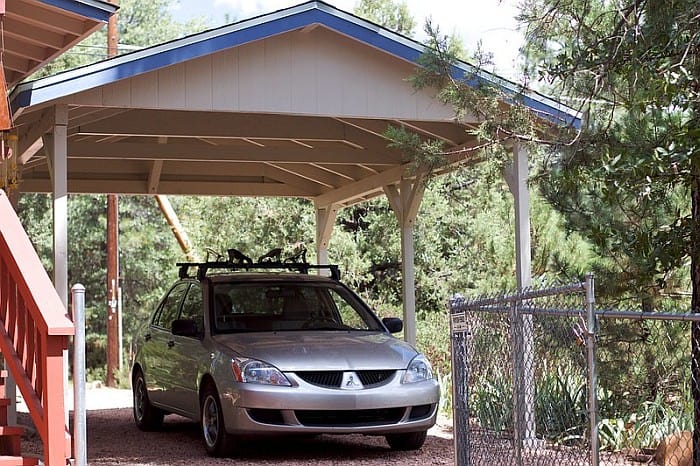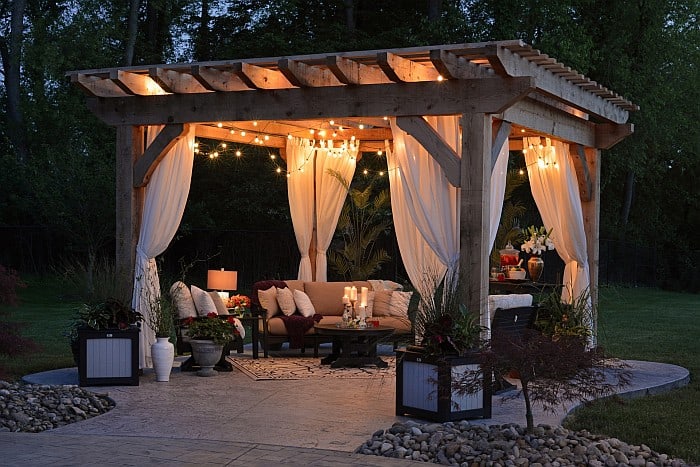What is an accessory structure? An accessory structure is an outdoor structure located on the same property as the house and is used by its residents. Accessory structures are garages, sheds, gazebos, and even swimming pools and fences. All these structures have to adhere to local regulations.
Do you want to build a storage shed in your backyard? Don’t know which building regulations to follow?
A lot of homeowners have difficulty classifying their new backyard projects. Knowing what type of building you are building is essential, so you can follow your local rules and regulations.
Most backyard structures are accessory buildings and some may require a building permit. But, what is an accessory building exactly?
I will clue you in on what an accessory building is and what regulations are set for them. Let’s dive in!
Contents
What Is An Accessory Building?
The Definition

The official definition of an accessory building describes it as: “a structure which is on the same parcel of property as a principal structure and the use of which is incidental to the use of the principal structure.”
An accessory building is a building associated with a dwelling. It is most commonly a backyard structure that is attached or detached from the house. Accessory structures are used exclusively by the owners or occupants of that house or residential building.
Accessory buildings can be residential or commercial. Today we will focus on residential accessory buildings and some of their regulations.
There are two main types of residential accessory buildings:
Type A:
A Type A accessory building is an enclosed space that can be used as domestic storage, a garage apartment, living quarters, or a garage for automobiles or trucks weighing up to 1.5 tons. Any accessory building over 12 feet in height is considered a Type A accessory building.
Type B:
Type B accessory buildings are used strictly for the storage of bicycles, patio furniture, tractors, lawnmowers, riding mowers, and other lawn maintenance tools and equipment. Type B accessory buildings also include gazebos, greenhouses, carports, home workshops, and hobby shops.
Both type A and B accessory buildings can be attached or detached:
- Attached: A building that is directly attached to the main building with no common access between the two buildings.
- Detached: A building located on the same lot as the main building and is not structurally attached to it.
Examples Of Accessory Buildings

Now that we know the definition of an accessory building, we can put things into practice. Here is a list of common accessory buildings you will often see next to a house or other residential buildings:
- Garages
- Storage sheds
- Gazebos (read more about them here)
- Pavilions
- Pergolas
- Greenhouses
- Garden structures
- Playhouses
- Pool houses
- Swimming pools
- Boathouses
- Cabanas
- Home workshops
- Home hobby shops
- Decks
- Docks
- Patios
- Fences
Each and every one of these structures can improve the quality of your home life. Don’t be discouraged to build one in your backyard because of the building regulations and permits. You can start with a pergola.
Click here to get to know the purpose of a pergola. Watch this video on how to build one from scratch. It is pretty simple.
I encourage you to take a look at these ideas, as well:
- Backyard pavilion ideas you didn’t know you needed.
- Gazebo ideas that will transform your backyard.
- Enclosed patio ideas that will give your house a new look.
Rules And Regulations Of Accessory Buildings

Most cities have specific rules and regulations in place for accessory buildings. Here are some of the most prominent ones I have found. These can vary from area to area, so you should contact your local authority for detailed information.
- Accessory buildings that measure 120 square feet or larger require a building permit. The same applies to any accessory building over 13 feet in height, regardless of the square footage.
- The height of the Type A accessory building shouldn’t exceed the height of the principal structure.
- The height of the Type B accessory building shouldn’t exceed 13 feet.
- The placement of an accessory building has to meet the “setback.” This is the minimum distance between a property line and the proposed structure. These distances between structures and property lines are set by the City. Click here to find out more about the best shed placement.
- Accessory buildings can’t be rented or occupied by anyone except the occupant of the principal structure.
- Accessory buildings can’t be used for any business purposes or any customary home occupation.
- Properties smaller than one acre can have a maximum of two accessory buildings, of which only one can be a Type A accessory structure.
- Lots measuring one acre or more can have a maximum of three accessory buildings, of which only one can be a Type A structure.
- Square footage of accessory buildings located on properties less than one acre in size can’t exceed 75% of the square footage of the first floor of the main structure.
- Square footage of accessory buildings located on one-acre lots or larger can’t exceed the total square footage of the first floor of the main structure.
- The first-floor size of the principal structure combined with the floor size of the accessory building(s) can’t exceed 50% of the total property size.
- Cargo storage, trailer storage, and other containerized storage are not considered accessory buildings and are not permitted on properties used for residential purposes.
FAQs
Is a gazebo an accessory structure?
A gazebo is an accessory structure if it is located on the same property as the house or residential building and is used by its occupants. If the gazebo is attached to the house, it is still considered an accessory structure.
Is a shed an accessory building?
A shed is an accessory building if it is located on the same lot of land as the house and is used by its occupants. Cargo storage and trailer storage are not considered accessory buildings.
Is a carport considered an accessory structure?
A carport is considered an accessory structure if it is located on the same lot of land as the house. An attached carport is considered a part of the main structure if the number of accessory structures on that lot would otherwise exceed the maximum limit.
Is a deck an accessory structure?
A deck is an accessory structure if it is located on the same property as the main structure and is used by its occupants. A deck will require a building permit if you cover it with a roof. Other similar constructions, like patio and dock, are also accessory buildings.
Is a fence an accessory structure?
A fence is an accessory structure if it is located on the owner’s property where the main house is located. Generally, fences don’t require a building permit. Still, they must comply with local regulations that determine the permissible location and height of the fence.
Is a pool considered an accessory structure?
A pool is considered an accessory structure if it is located on the same lot of land as the principal structure and is used by its occupants. This includes both above and in-ground pools. Pool houses and cabanas are also considered accessory structures.
Accessory Buildings & Structures Regulations – Don’t Get Discouraged
A lot of homeowners get discouraged when they hear some of the regulations their innocent backyard project has to comply with.
But things aren’t all that scary, now that you know and understand the definition and standards of accessory buildings. I encourage you to contact your City and ask “What is an accessory building?”
Don’t let the paperwork get in the way of having your very own gazebo, storage shed, or swimming pool in the backyard.
Do you agree? Let me know in the comments below, and feel free to ask any questions.

Would an equipment pad repour (contractor did not compact soil under first concrete pad) with ALL plumbing and electrical pipes coming up through pad (yep, I know) need to be reinspected?
Would a garage that is attached to a house and has a door into the garage from the house not be an accessory building because having access from the main house?